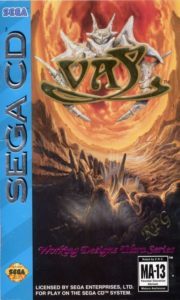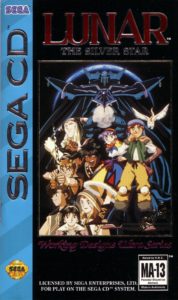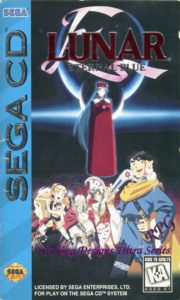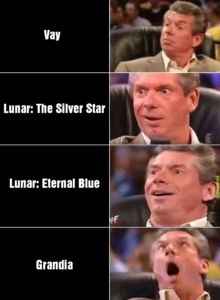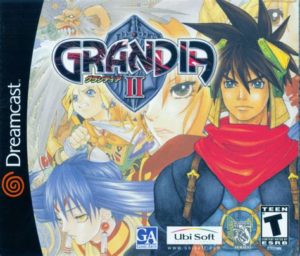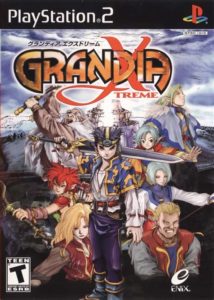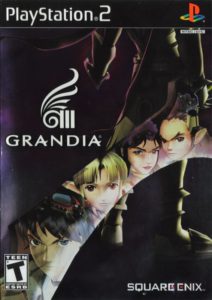I’ve mentioned recently how I’ve gotten into playing classic JRPGs. That actually started by accident in a couple of ways.
First, I made two games (here and here) in RPG Maker, which makes JRPG-style games by default. As I was making them, play-testing them, and eventually playing through those finished games, I realized that I enjoyed that style of turn-based stats-influenced gameplay.
The second way happened because of when I injured my back at the very start of this year. I mentioned that while talking about playing through the Yakuza series, and Yakuza Dead Souls in particular:
“I threw my back out while playing it – quite literally. It turns out that a cheap office chair I had been using had been slowly giving me lower back problems, and it was during an evening session of playing this game that I suddenly got horrifically painful back spasms and pain. I had to go to the hospital, in fact.”
That happened on New Years Day, and when I returned home from the hospital, I realized I had to switch up my routine of sitting in that same chair for hours in the evenings playing games on my gaming PC.
So I decided to get into some retro, classic 8-bit and 16-bit video games again. I could do this in a different and more comfortable chair while sitting in front of a CRT television hooked up to an emulation mini PC. And it did wonders for my back, as well as getting up to stretch and walk around more often.
But while I was using that emulation PC, I was limited to older games up to around the turn of the century. No big deal, as there are thousands of interesting games I haven’t played yet from that era. My search for interesting and fun games led me to going through my collection of Sega CD games, pretty much because I had my 6-button controller plugged in.
And for whatever reason, I went near the end of the alphabet and booted up a game called Vay, knowing almost nothing about it. I soon realized that it was a JRPG with translated and voice-acted anime cutscenes. I usually would have tried something else, but this time I stuck with it. I’m glad I did because the story of Vay is actually kind of interesting.
The gameplay was really fun too, and the music was also pretty great. The more I played Vay, the more I liked it. I came back to it night after night for a couple of hours each night, and finished it after a few weeks. It was grindey, but I enjoyed the overall experience.
So then I deliberately went looking for another 90s JRPG to play. I recalled that I had heard lots of great things about the Lunar series of games on the Sega CD.
So I loaded up the first game “Lunar: The Silver Star” and started playing. I was immediately reminded of a previous attempt at playing this game about a decade ago. In that attempt, I wandered out in the wilderness to do some grinding – without a weapon, armor, or any party members. I was killed by the first low-level enemy I encountered and I quit in frustration, lol.
But this time I paid attention to what I was doing. I talked to the people in the town and got the things I needed to proceed, and I soon fell in love with the game, its characters, its story, and its music.
After finishing Lunar: the Silver Star, with its wonderful ending, I played the sequel Lunar: Eternal Blue.
This game was better in every way, except for the story. But I enjoyed it too, and playing through it further entrenched my newfound love for the JRPG genre. I think it’s safe to say that by the time I finished the second Lunar game, I was hooked.
I tried next to play Lunar: Strolling School, which was a Game Gear title released only in Japan. I played an English-patched version that got corrupted and unplayable on me, so I couldn’t continue. I also considered playing Lunar: Dragon Song, but I soon learned that it’s not just considered to be the worst game in the series, but the worst JRPG ever made.
Ouch.
So I did some reading and made a list, and chose to go with a game series that I had held in my mind for a long time – Grandia.
Grandia is kind of hard to actually get into because of its comparatively slow and confounding start, but once I got into it… oh boy, did I get into it.
This instantly became one of my favourite games of all time. I’m talking in the top five games I’ve ever played, along with Age of Empires, Lords of the Realm II, Road Rash 64 and Fallout 4. Yes, I love this game that much.
Grandia remains – out of the RPGs I’ve played – the one with the best written story, the best written characters, the nicest and most beautiful art style, and the most fun gameplay.
The game starts out as just a simple adventure for adventure’s sake. When you play Grandia, you start out as a young kid named Justin who wants to be an adventurer. And that fun, lighthearted spirit is maintained through most of the game until darker things start influencing the plot.
But it’s the turn-based combat system and its depth and comprehensiveness that really make this game fun to play. It’s not just turn based, but influenced by a real-time stat called initiative. This initiative stat can speed up player or enemy turns, be cancelled by attacks, and be improved by leveling up or equipping gear. The layout of the battle field also influences the battles, with player characters having to traverse across and around enemies to attack or to dodge. This brings up stats like movement and speed, and all these factors need to be considered while going through the turn-based battles.
It’s hard to explain, but playing through a battle for a few minutes will give you a feel for it. The way things play out is actually quite intuitive and fun.
So with this very fun and rewarding battle system, I found myself enjoying not just the story of the game as it unfolded, but the great level design, the sprites on 3D background look of the game, and its incredible music. I played through Grandia for 62 hours, and actually cried tears of joy at the ending. That’s a first for a video game to have that kind of affect on me.
Of course, Grandia II came next. I had been wanting to get around to playing this one for about 20 years, oddly enough because one of the characters (Tio, that girl with blue hair on the cover) is a robot.
I finally did, and it’s also one of my favourite games now. Grandia II is not as good as Grandia, I think, but its battle system is slightly different and a little more refined and expanded in some ways. It’s still lots and lots of fun to play, and I’m actually currently replaying both games right now, just because they are so much fun to play.
But whereas Grandia was a fun and lighthearted story that only really turned serious near the end, Grandia II is dark and dire from the start. Grandia II is essentially about good vs evil. Plenty of art, stories, and games deal with that, but Grandia has its own twists concerning demonic possession and identity that make its story really interesting.
Unfortunately, that story isn’t told as well as the story in the first game was. That game had some of the best pacing and story telling I’ve experienced in a game. Grandia II’s story telling is just not as good. There is some very interesting back story between two crucial characters that isn’t even explored in the game. I only learned about it by reading a contemporary interview with the game’s developers. They also said that the scenes which explored that relationship were “cut by someone else”.
This, and the games rather short length give me the impression that it should have been about twice as long as it is. There are some scenes with massive exposition and info-dumps, which should have really been better told through gameplay somehow. And even after finishing the game, learning all the plot twists and secrets it had been holding – there was so much that I realized could have been expressed in better ways. I especially realize this as I make my way into a second playthrough.
But as it stands, it is a great game for what it is. The art style is just as strong as it was in the first Grandia, though appears a little bit dated now because of the early 3D polygon models utilized. It’s just as much fun to play, and maybe even more fun to just go through areas and do battle with monsters.
After finishing Grandia II, I naturally looked toward the other games in the series, the obvious choices being Grandia Xtreme and Grandia III.
Only a game released around the turn of the century could include the term “Xtreme”.
And the writing, dialog, and voice acting in this game are astonishingly bad. I couldn’t believe that this game is part of a series which includes Grandia. I only spent 4 hours with it, and will not ever touch it again for its auto-centering camera feature which turns you around in a random direction to “help” you while you are using the manual camera controls to try and navigate a fucking corner.
From what I’ve heard, this game has almost no story and is just an excuse to have the admittedly great Grandia battle system in a game. However…
This entry in the series – the last one, by the way – is kind of notorious for a few reasons. I had read that the story was good for the first half of the game, and then promptly falls off a cliff. I wouldn’t describe it quite that way.
For me, the story of this game is nonsensical and implausible in so many ways that it’s a pretty tall order to be asked to take it seriously. I actually don’t know how the whole story goes because I stopped playing about a third of the way through, and I won’t be coming back to it.
The writing and dialogue in this game are also really bad, just a few steps above Grandia Xtreme. But they’re nowhere near worthy of attention or serious consideration, and especially not anywhere near what the first two games offered. I also saw that the plot, themes, and overall idea of both Grandia and Grandia II were being shoved into this games plot. It’s as if this game was trying to be half Grandia, half Grandia II, and half its own thing. And that don’t add up.
This game’s story and dialogue feel like they were written by committee. It feels like 50 different people in 50 different offices wrote different sections of this game, and then they were all stitched together by someone who didn’t know how they were supposed to fit.
The characters are all really bland and underdeveloped, except for one. That one character is the most capable and most likeable character in the game, and she just leaves the party very early on for no real reason other than to give this game the same kind of “adventurer coming of age” feel that Grandia had. It was all downhill after that point.
I stopped playing because of a massive difficulty spike, which I read was just a little wee difficulty spike among many more to come which make the game unwinnable if not unplayable. I play games to relax, they’re not my job.
And that brings me to what I have to say about the combat system in this game and in Grandia Xtreme. In the first two games, there were many factors to consider during battle, including which enemy had the next turn, whether or not an enemy would use a special attack, placement of player characters and placement of enemies on the battlefield. As one played through a battle, one had to consider placement and distance of a target, whether it could be reached in time for attack, whether its next attack was going to be a devastating special attack, and so on.
That’s what makes the battles in those first two games so fun and engaging – you have to actively think and the situation changes with every turn.
With these last two games, things changed a lot. Now, enemies almost always use a special attack on every turn. If you don’t immediately counter that special attack on that specific enemy, you are going to get wrecked. Battles then become a case of checking through the next enemies in the lineup to see which ones are next, and which ones will be performing a special attack, and then performing a special attack or critical hit of your own to hopefully cancel that attack.
That removes the whole placement and movement element that the previous games had going for them, and changes the battles into a matter of looking up enemy status and then choosing which enemy to attack based on that. It’s the JRPG equivalent of spamming a punch attack in a fighting game. It feels way different, isn’t as fun, and gets boring after a while.
And then of course there are the difficulty spikes I mentioned which punish you for not using the exact weapons, armor, magic, and other items on specific characters to deal with certain overpowered enemies who can one-shot your entire party – and they aren’t even bosses.
Ain’t nobody got time for that.
So I think that’s one of the reasons why there hasn’t been a new Grandia game since. It’s a shame, because I think Grandia III had the potential to be something much better than it was. The graphics are really great, actually, and it’s a very nice game to look at. The same great, creative, and inspired level design that was in the first two games is intact here too. There are free-roaming flying sections which hint at plans for an open-world kind of experience that never was.
Oh well. We still have the first two games and a couple of spinoffs to play. There was a quick and dirty port to PC and consoles done several years ago, which is available on Steam. From what I’ve seen and read, the graphics are blurry and smeared out, the sound is messed up, and there are lots of bugs that make the games crash. But if you want to buy these games now, that’s your only option.
I emulated these, playing Grandia on Duckstation and Grandia II on Redream. I had no problems at all, and they looked and played great on my CRT television. You know what I always say… Don’t hesitate, emulate!
